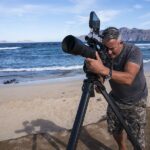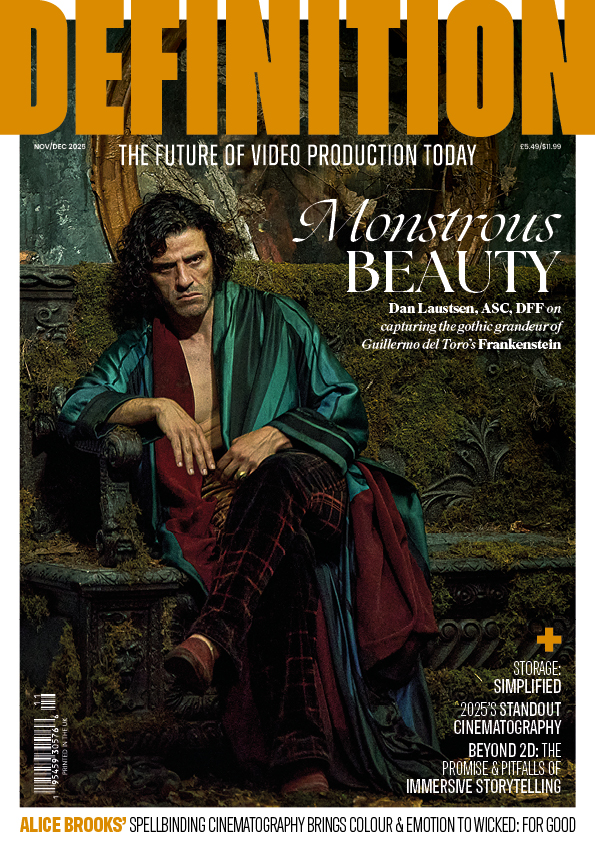
Fight Like A Girl
Posted on Jul 3, 2024 by Samara Husbands
Packing a Punch
Richard Henkels talks us through lensing Fight Like a Girl , the first western narrative feature to be shot entirely in the Democratic Republic of the Congo
From its opening scenes, Fight Like a Girl pulls no punches, plunging viewers into the brutal reality of its central character. Inspired by true events, the film follows Safi (Ama Qamata), a 19-year-old girl forced to work at an illegal mineral mine in east Congo. The job is dangerous and the men overseeing it even more so, but Safi’s story takes a hopeful turn when she escapes her captors for the border city of Goma. There, she finds a new life and discovers a natural talent for boxing, eventually fighting her way up to the Congolese Championships.
Anchored in the real-life experiences of an all-women’s boxing club in the region, the feature is the first western narrative feature to be shot entirely in the Democratic Republic of the Congo (DRC). For cinematographer Richard Henkels, bringing to light the story – and the broader context of the region – was a big responsibility but also a privilege.
“I’m amazingly proud and feel fortunate to have been given the opportunity, as a white man, to help represent this beautiful country which has been abused over the years,” he reflects. “It’s also extremely important because, unfortunately, what’s going on in East Africa isn’t at the forefront of attention in the media.”
Blood minerals
Branded the rape capital of the world, the DRC has been plagued by decades of civil unrest, violence and corruption. Though one of the poorest countries, it is rich in natural resources, including a wealth of minerals. As Henkels notes: “It’s the only area where coltan and cobalt, essential for lithium-ion batteries in our devices, are found. China foresaw the need for these minerals decades ago and embedded itself deeply in the East African government and, unfortunately, it’s very corrupt.
“A general runs the country and none of the money goes back to the people,” he continues. “As well as the legal mines, there’s tonnes more unregulated mineral mines controlled by gangs like the M23 and the FDLR. They rape and pillage, kill the elderly men and take the young boys to indoctrinate them. They take the women as slaves, either on the sex trade or in the slave camps to mine. It’s a horrible cycle of abuse.”
The film was shot in just 24 days and cut within a few months, but all told, the process was much longer – beginning years earlier with director Matthew Leutwyler’s charity work in the region. Through his organisation We Are Limitless, which works to support young people in the DRC and Rwanda, he discovered a group of female boxers being mentored by coach Kibomango. A former child soldier and champion boxer, he not only taught these girls self-defence, but also provided a path out of exploitation and homelessness.
Blaze of brilliance
Initially, the team considered shooting in other areas of East Africa that might be more conducive to production, but realised details like accents would be off if they went elsewhere. Nor would they get the beautiful backdrop of Mount Nyiragongo – an active volcano whose lava smoulders menacingly just a few miles outside of Goma. “It’s very iconic,” explains Henkels. “We felt the growth of this ring of fire was representative of the turbulence of what was going on within the community.”
The budget was tight and both crew and equipment were limited – but the team rolled with the punches and made it work. “We wanted it to be ‘not Hollywood’ and not contrived; we wanted an almost docu-style, very realistic but obviously controlled, since we had to follow a script,” explains Henkels. “Even though we had several restrictions, it kept us on our toes and drove our creative process.”
While searching for a lead actress and sourcing funding, they put together a local crew, who began to document Kibomango and the girls from the boxing club. Joined by the director, producer and focus puller, the local cameramen and drone operator started chronicling the girls’ lives and getting to know the community. “It gave them boots on the ground as well as an insight into how to pull off an actual narrative feature – so by the time we were given the green light to jump in and shoot the film, the director already had the locations plotted out. He had essentially scouted everything for me, so I was able to come in and prep with all that information and knowledge,” shares Henkels. “By the time I showed up in Congo, pre-production was really smooth and fast.”
Beating the odds
Pre-production may have been plain sailing thanks to all the prep work, but principal photography threw up plenty of challenges for the crew. From navigating complex local politics to erratic power supplies, every day yielded problems to manoeuvre around. “There’s no real organisation or structure there, so you might think a location is secured – but then find out it’s controlled by different people at night. It was stressful, but that unpredictability made the experience magical. It’s a bit like the Wild West, but the people are so beautiful and embraced us with open arms,” says Henkels. “Of course, you always have to watch your back, but they really accepted us.”
He recalls the technical hurdles vividly: “Running into difficulties with no proper lighting was a nightmare. My crew had to run makeshift wiring from a generator, and by the time the power reached my lights, they were barely glowing,” he laughs. To light key nighttime street scenes, Henkels got creative: “I needed to figure out how to light a huge area with no lights, so I asked the producer if we could burn tyres like the locals did. We bought 20 truck tyres and kept them burning throughout the night – hoping the wind didn’t change direction – but God, it was so beautiful. Burning rubber would stay engulfed in this giant flame. I used the Sony VENICE, which has a very sensitive sensor – I was exposing at 3600 ASA with the Canon CN-E lenses shooting at T1.4 – the warmth and colour from the lenses was stunning.”
In Focus
Henkels was drawn to the CN-Es for their unique softness and the beautiful roll-off of focus they provide. He also needed something up to the task of shooting in extreme low-light conditions without compromising on image quality. “I knew I needed a camera with a fast ISO, and then the next question was: what lenses can cover full-frame and be fast at T1.4?”
After some testing, he realised the CN-Es were an ideal fit for the project and started prepping the camera through Camtec in LA. Working with Kavon Elhami – the rental outfit’s president – the lenses were customised to dial in the specific look Henkels was after for the film. Elhami suggested a modification to reduce contrast and add softness towards the edges, enhancing the artistic feel of the visuals. “He took the front element, just the front edge of the set, and buffed off the coating to be able to detune the lens a little bit to give it a bit more of an edge,” elaborates Henkels.
Before heading to the Congo, Henkels meticulously planned the feature’s visual aesthetic. “I shot some tests and then sent them over to Adrian, my colourist, and we created a couple of LUTs,” he explains. “With the grouping of Canon, Camtec and Adrian, I established the set look. When I landed in Congo, everything was situated. I didn’t have the luxury of rolling with a DIT; we shot insanely fast due to the uncontrolled background.”
Working in various unpredictable surroundings meant Henkels had to think on his feet. “We would install actors and our scripted environment into a small, tight control area and let the background be organically natural, which really shows in the film.”
Henkels is full of praise for the CN-Es, which offered exceptional quality and nailed the aesthetic he was aiming for. “Canon gave me the opportunity to do the final projection, before the final grade, with my colourist and the producer on their beautiful projecting set-up in Burbank. I was blown away by the lenses – they were phenomenal. I must have shot the whole film on T1.4 wide open the entire time.”
Knockout performances
When it came to capturing the boxing scenes in the arena, Henkels wanted a different feel from the street fighting shown earlier in the film. The director asked for a more sporty action piece, placing the audience right in the thick of things, which they achieved with zooms, snap zooms and precise choreography. “I ended up using the Blackmagic Pocket Cinema Camera – super compact – with an on-board monitor and just the lens. I could hold the camera and the lens, and we used a super-light Micro Force motor. I built a leash to the camera and to my hand, allowing me to put the camera right in between the opponents, so it was immersed,” he shares. “It put the viewers right there in the boxing match and it was incredibly effective at helping them to get tapped into what Safi is experiencing.”
Looking back on the journey of creating Fight Like a Girl, Henkels expresses immense pride in the collaborative effort and the exceptional talent of the cast and crew. “It’s amazing when you’re given the opportunity to work with such an amazing script and dialogue that tells such a beautiful story,” he concludes.
“Qamata and Hakeem Kae-Kazim’s performances were so deep and soulful. Leutwyler’s work was incredible – and the score is amazing too. I’m honoured to be a part of such an amazing team, who worked in such insane circumstances to pull off a film with such a beautiful and powerful message.”
This feature was first published in the July 2024 issue of Definition.









